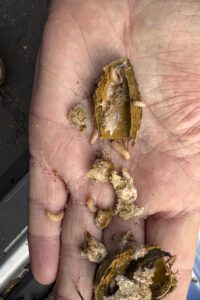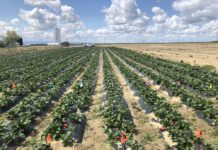
Listen to the audio version of this article. (Generated by A.I.)
“Master the basics or all the other fancy stuff you try won’t work.”
That, in a nutshell, is the message to almond growers about the importance of good orchard sanitation from processors, UC advisors and crop consultants. Sanitation is known as the foundation for navel orangeworm (NOW) control by reducing overwintering sites for larvae. Skipping this important management step in the fall and winter means almond growers will play catch-up with NOW control throughout the growing season.
NOW damage in this year’s almond crop, as predicted due to last year’s high NOW pressure, is meeting expectations. Mel Machado, Blue Diamond Growers’ chief agricultural officer, said reject levels have ebbed and flowed during harvest this year, with early Nonpareil deliveries sustaining elevated damage levels similar to what was recorded in the 2024 crop. Reject levels have improved as the harvest has progressed. However, some have been surprised by undesirable losses. He also noted that the invasive carpophilus beetle has been found in orchards. Feeding by this pest also causes kernel damage. Good orchard sanitation is currently the only option for beetle control.
NOW is the primary insect pest of almonds in California. The Almond Board of California reports NOW infestations pose a significant risk due to crop damage and introduction of Aspergillus mold, which produces aflatoxins, a food safety risk. Almonds are vulnerable at hull split when female NOW lay eggs. After hatching, NOW larvae bore into the nut and feed on the kernel.
Growers, handlers and UC advisors interviewed for this article agree that properly done orchard sanitation is the basis for NOW control throughout the season.

Reduce Inoculum
“Good sanitation reduces the inoculum in the orchard, there are fewer NOW adults to produce the next generation,” Machado said, though he concedes that a neglectful neighbor can throw a wrench into a grower’s NOW control plan if their orchards are not sanitized.
“Those orchards that were properly sanitized have been running low on rejects and those that weren’t are running much higher this year,” Donny Hicks, grower relations at RPAC Almond Growers and Processors in Hughson, said.
“Even with outside pressure, getting rid of the overwintering NOW population in your orchard will go a long way in preventing high damage in your almond crops,” Franz Niederholzer, UCCE advisor, said.
Machado noted a high percentage of almond orchards were not sanitized last year, no doubt contributing to the higher reject levels at the processor.
In his latest crop report, Machado said reports of low NOW trap catches as the Nonpareils approached critical hull split timing faded as trap captures increased precipitously during the split. Catches then increased again for the third “flight” during August, threatening the later-splitting pollinizer varieties. He also noted that the carpophilus beetle has been observed in several orchards, adding to kernel damage.
Differences between properly sanitized orchards and those that received no or only cursory sanitation are obvious, said Hicks. He said orchards that were properly sanitized after harvest were yielding loads of nuts with low reject levels. Those orchards that were not sanitized had much higher reject levels. Hicks said his winter sanitation plan is to shake on days with very high humidity, even if it is later in the year. The added weight on the mummy nuts from the moisture leads to a cleaner shake. He stops shaking during dry periods. Hicks notes that sweeping mummy nuts into windrows and flail mowing to destroy the mummies is essential.
“Pretty much every mummy comes off the tree in wetter conditions. This level of sanitation led to my lowest reject level in a year with 0.45% in the Independence and 0.54% in Shasta,” Hicks said.
The Almond Board’s working goal for the industry is to keep almond harvest rejection levels below 2% and to strive for 1% or less. Damage levels over 2% call for a stronger orchard sanitation program, aided by chemical control.
That program begins with orchard sanitation efforts that take mummy nut levels below established thresholds. UC IPM recommends counting mummies in 20 trees in an orchard, including all varieties in the orchard in the count, and calculating an average count per tree. UC IPM sets a threshold of no more than two mummies per tree in the northern San Joaquin and Sacramento valleys and no more than one mummy per five trees, along with no more than eight mummies on the ground under each tree in the southern and central San Joaquin valleys. The target date to sanitize to these thresholds is February 1. These threshold numbers are research proven.

Check Your Work
Even a well-planned sanitation program can be rendered less effective due to human error.
“Did you go out and look to see how well sanitation was done?” asked Niederholzer. Nuts trapped in low spots or between irrigation hoses need to get blown to the centers. Drivers pulling flail mowers or shredders need to go slow to make sure mummies are destroyed. Niederholzer advises checking the middles to see if all mummies were destroyed. If that isn’t the case, he said another pass is needed.
“You also have to make sure your drivers are doing a good job, not going too fast and checking to make sure the mower is working properly,” he added. “Check to make sure there are no missing blades on the mower.”
If dry weather makes shaking conditions unfavorable, there is research showing late shakes, even as late as early February, can be done without reducing yields.
Crop consultant Wes Asai noted his orchard sanitation research in a 2020 West Coast Nut article. Trials done in 2018 and 2019 in young and mature bearing Nonpareil trees showed shaking on February 6 removed an average of 6,784 buds per tree and on February 6 removed an average of 9,626 buds per tree. Mature Nonpareil trees have an average of 38,000 blossoms. Asai said there was no negative impact on yield from that level of bud drop.

Cecilia Parsons | Associate Editor
Cecilia Parsons has lived in the Central Valley community of Ducor since 1976, covering agriculture for numerous agricultural publications over the years. She has found and nurtured many wonderful and helpful contacts in the ag community, including the UCCE advisors, allowing for news coverage that focuses on the basics of food production.
She is always on the search for new ag topics that can help growers and processors in the San Joaquin Valley improve their bottom line.
In her free time, Cecilia rides her horse, Holly in ranch versatility shows and raises registered Shetland sheep which she exhibits at county and state fairs during the summer.















